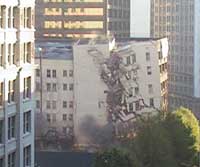~ Urban Renewal ~ |
|
All American cities have experienced, to some extent, an exodus of business and residents to the suburbs – especially cities in the northeast. Community leaders have sometimes decided that it is older downtown buildings that are to blame. As a result, large downtown areas have been leveled in the name of "urban renewal."
More recently, large areas have been leveled in order to build suburban style developments. Downtown was loosing shoppers to the suburban shopping malls. Why not – the reasoning went – build shopping malls downtown to bring the shoppers back? The Galleries on South Salina was such a project. In most cities, as in Syracuse, after spending enormous amounts to build them, these new downtown malls have attracted no more business than the buildings they replaced. Other times historic buildings were simply destroyed in the hopes that something better would follow. We've been waiting since 1970 for something new and better to be built on the former site of the Yates Hotel.
So what strategies have succeeded in bringing renewed life to downtown?
In Syracuse the only
downtown area that has shown renewed economic life in recent years is
Armory
Square. This wasn't a huge government led project and it didn't
depend on massive government subsidy. It was started by
enterprising business people who shared a vision of the kind of
development they would like to see. And it depended for its
success on the type of historic architecture destroyed by failed urban renewal
attempts.
Statistics consistently show that preservation projects create more
jobs, income, and wealth than comparable new construction projects
–
while preserving an area's history in the process
(see
Profiting
Through Preservation).
|
 In the 1960's and 1970's these leveled areas were often covered with
windswept new plazas hosting modern high-rise office towers
– like the MONY plaza and towers downtown. It wasn't until years later that
people started to notice that no one was using these new plazas (to
understand why go to
In the 1960's and 1970's these leveled areas were often covered with
windswept new plazas hosting modern high-rise office towers
– like the MONY plaza and towers downtown. It wasn't until years later that
people started to notice that no one was using these new plazas (to
understand why go to